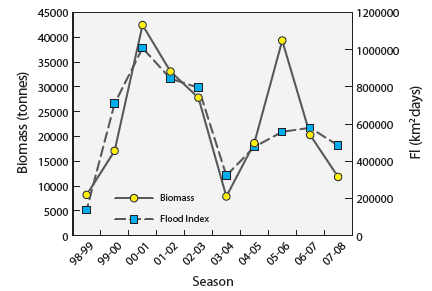2. Flood benefits
2.3 Flood benefits - the Mekong fishery
The annual mono-modal flood-pulse of large tropical rivers such as the Amazon, Congo and Mekong is the dominant ‘trigger’ in the annual cycle of ecological processes within the fluvial system, bringing about a distinct seasonality in the annual hydro-biological cycle between an aquatic phase and a terrestrial phase (Junk et al., 1989). As a consequence there are highly seasonal biogeochemical cycles, growth rhythms and life cycles amongst the many species of ecosystem system biota such as algae, macrophytes, trees, fish and invertebrates (Junk, 1997; Junk et al., 2000). The annual inundation of the floodplain, particularly in Cambodia and specifically around the Tonle Sap and Great Lake, makes available a huge biomass to the aquatic food web which boosts aquatic productivity and results in a prolific ecosystem.
The major manifestation of this virtually unrivalled level of aquatic productivity is the Mekong fishery, amongst the largest of its type in the world. Hortle (2007) estimated that in 2000 the yield of fresh water fish in the basin, minus the aquaculture component, was approximately 1,860,000 tonnes. Combining this figure with an estimate of the size and first sale vale of the fish of between US$1.0 and US$1.8/kg, the total value of the fishery is indicated to be US$2,600 million if a median figure of US$1.4/kg is adopted. Using a proportional breakdown of estimated fish yield by country given in (Hortle, 2007), the following national estimates are obtained:1
| Country | Value
of national inland fishery based on 2000 estimates (US$ million) |
| Cambodia | 608 |
| Lao PDR | 212 |
| Thailand | 900 |
| Viet Nam | 880 |
| Total Lower Mekong Basin | 2600 |
The figure for Viet Nam reflects the role of aquaculture production, which in effect is independent of the annual flood pulse. Elsewhere, it is clear that the flood regime plays a pivotal role, most particularly with regard to migrant fish capture which accounts for 71% of the total fish yield (Barlow et al., 2008), no more so than in Cambodia. In Thailand the major basin fishery lies in the Mun/Chi Basin and in tributaries such as the Nam Songkhram while in Lao PDR it is a significant element in socioeconomics throughout the country, both on the mainstream and within the tributary systems.
Other aquatic animals (OAAs) such as frogs, crabs and molluscs are also very important in terms of their contribution to regional diet and livelihoods and their breeding cycle and yield is closely allied to the seasonal flood cycle. Hortle (2007) provides annual yield estimates which can be converted to a US$ value by assuming an average sale price, a figure of US$0.50 kg being a reasonable one according to the MRC Fisheries Programme. As the figures in Table 2.4 indicate their annual regional value could be close to US$250 million.
in the Lower Mekong Basin.
| Country | Estimated
annual yield of other aquatic resources (tonnes) |
Value
based on an average sale price of US$0.50 kg (US$ million) |
| Cambodia | 105,500 |
52.75 |
| Lao PDR | 40,500 |
20.25 |
| Thailand | 191,000 |
95.50 |
| Viet Nam | 161,000 |
80.50 |
| Total Lower Mekong Basin | 498,000 |
249.00 |
That there is a very strong link between the annual fish catch and the extent and duration of flooding is intuitively clear. The most researched component of the overall Mekong fishery is the so called dai, or bagnet, fishery that exploits the annual migration of fish out of the Great Lake in Cambodia towards the Mekong via the Tonle Sap towards the end of the flood season (Figure 2.6).
Figure 2.6: The dai, or
bagnet fishery, on the Tonle Sap,
Cambodia.
Halls et al. (2008) propose a flood index based upon the sum of the number of days that a given area is flooded during around the Great Lake each flood season, which provides an indicator in units of km2 days. Figure 2.7 shows the relationship between this statistic and the annual dai catch in terms of fish biomass.
The higher fish biomass during years of extensive and longer duration flood inundation, as in 2000, 2001 and 2002, reflects that under such conditions the fish caught are bigger on average which in turn indicates the longer that they have to breed and feed amongst the rich organic resources of the flooded areas the larger they grow and the more mature they are once they begin to migrate.
These huge figures regarding the estimated value of the Mekong aquatic resources, particularly fish, are regarded as conservative as they do not take account of the economic benefits that flow from the trade, processing and preservation of fish products. Nor do they include the very considerable indirect values of the fishery such as its contribution to the nutrition, employment and well being of millions of rural people who generally have few other income earning and livelihood options (Barlow et al., 2008).
Figure 2.7: Estimates of fish biomass
arriving at the dai fishery and the annual flood
index proposed by Halls et al. (2008).
1 Though these national yields figures are derived from fish consumption data and therefore ignore cross-border trading they are nonetheless broadly indicative of production value.
Choose a newsletter:

